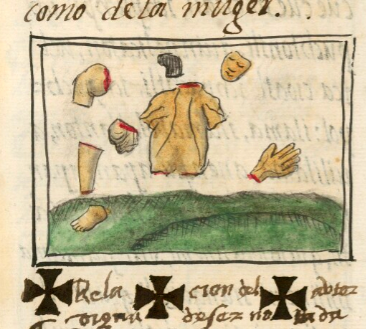nacayotl (FCbk10f70v)
This iconographic example, featuring a human body (nacayotl) that has been dismembered, is included in this digital collection for the purpose of making comparisons with related hieroglyphs. The term selected for this example comes from the text near the image in the Digital Florentine Codex. There is no gloss, per se. This example shows all the featured body parts suspended in air above a grassy field, which has some undulation (shading and three-dimensionality, showing European artistic influence). Interestingly, the hair from the head is treated as anatomy. The eyes being closed on the face is an indication that the person is dead. The largest piece is the torso, keyworded by the DFC team as tlactli. Some of the body parts show a small amount of red blood on the edge where they were severed. The treatment is something like the butchering of an animal, where pieces were randomly hacked apart. Nacatl (the root of nacayotl) can refer to meat or flesh.
Stephanie Wood
Typically, in this digital collection, body parts are employed as elements in compound glyphs, providing phonetic indicators, such as -tzin- (from tzintli, buttocks, for a reverential), or -ma- (from maitl, hand or arm, for mani, in the manner of, or various syllable options), -ten- (from tentli, lips, for edge), -acol- (from acolli or ahcolli, shoulder, for bend), -tlan- (from tlantli, teeth, for a location), -cua- (from cuaitl, head, for the syllable), -nacaz- (from nacaztli, ear, for on the side), -ix- (from ixtli, eye, for the syllable, -xo- (another syllable, represented by a foot), etc. Body parts were also important in the formation of language for measurements.
Stephanie Wood
intonacaio
in tonacayo
Stephanie Wood
1577
Jeff Haskett-Wood
cuerpos, cara, caras, ojo, ojos, pelo, cabello, cabeza, pierna, piernas, brazo, mano, manos, pie, pies, rodilla, rodillas, torso, hombro
nacayo(tl), body, https://nahuatl.wired-humanities.org/content/nacayotl
el cuerpo (humano)
Stephanie Wood
Available at Digital Florentine Codex/Códice Florentino Digital, edited by Kim N. Richter and Alicia Maria Houtrouw, "Book 10: The People", fol. 70v, Getty Research Institute, 2023. https://florentinecodex.getty.edu/en/book/10/folio/70v/images/0 Accessed 10 September 2025.
Images of the digitized Florentine Codex are made available under the following Creative Commons license: CC BY-NC-ND (Attribution-NonCommercial-NoDerivs 4.0 International). For print-publication quality photos, please contact the Biblioteca Medicea Laurenziana ([email protected]). The Library of Congress has also published this manuscript, using the images of the World Digital Library copy. “The Library of Congress is unaware of any copyright or other restrictions in the World Digital Library Collection. Absent any such restrictions, these materials are free to use and reuse.”





